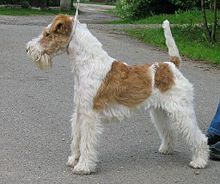Wire Fox Terrier
 |
||||||||||||||||||||||||||
| Other names | Wire hair fox terrier Wirehaired terrier Fox terrier |
|||||||||||||||||||||||||
|---|---|---|---|---|---|---|---|---|---|---|---|---|---|---|---|---|---|---|---|---|---|---|---|---|---|---|
| Common nicknames | Wire | |||||||||||||||||||||||||
| Origin | England | |||||||||||||||||||||||||
|
||||||||||||||||||||||||||
| Domestic dog (Canis lupus familiaris) | ||||||||||||||||||||||||||
| Classification / standards | |||
|---|---|---|---|
| FCI | Group 3, Section 1 Large/medium-sized Terriers #169 | standard | |
| AKC | Terrier | standard | |
| ANKC | Group 2 (Terriers) | standard | |
| CKC | Group 4 - Terriers | standard | |
| KC (UK) | Terrier | standard | |
| NZKC | Terrier | standard | |
| UKC | Terrier | standard | |
The Wire Fox Terrier is a breed of dog, one of many terrier breeds. It is a fox terrier, and although it bears a resemblance to the smooth fox terrier, they are believed to have been developed separately.
The Wire Fox Terrier is a sturdy, balanced dog weighing 7.7 to 8.6 kg (17 to 19 lb) for males and 6.8 to 7.7 kg (15 to 17 lb) for females. It should not be more than 39 cm (15 1⁄2 in) at the withers. Its rough, broken coat is distinctive. Coat color consists of a predominant white base with brown markings of the face and ears, and usually a black saddle or large splotch of color; there may be other black or brown markings on the body.
Two of the wire fox terrier's most distinctive traits are its energy and intelligence. It has a low threshold for boredom and requires stimulation, exercise and attention. The wire fox terrier is a companion animal that requires near-constant attention.
The dog should be alert, quick and ready to respond swiftly with enthusiasm. However, they should also be friendly, communicative, and playful if they receive the proper care and exercise. Bred to be independent thinkers, they are capable of tactical maneuvering for vermin and other sport.
Often, wire fox terriers are abandoned or surrendered for reasons that may include: running away instead of coming on a command; chasing cars, bicycles, other dogs, etc.; or taunting and then attacking other animals, including a household's cats and other dogs –and they are able to do serious damage. But these are actually normal behaviors for a breed designed to hunt not only foxes, but also badgers and boars, with no more fear of cows or buses than they have of small prey. Keeping one as a pet requires firm control to redirect these prey instincts and provide the dog with enough exercise and diversion. With diligent supervision, wire fox terriers can be amusing, exciting, long-lived companion animals.
Wire fox terriers kept for show are hand stripped; if the hair becomes too long, it is taken out by hand in order to preserve the colors and the glossiness of the coat. Many kept as pets are clipped monthly by a groomer. Clipping dulls the colors and makes the coat soft, curly and more difficult to keep clean, but it is preferred by many owners due to being a simpler (and cheaper) procedure than stripping.
The wire fox terrier was developed in England by fox hunting enthusiasts and is believed to be descended from a now-extinct rough-coated, black-and-tan working terrier of Wales, Derbyshire, and Durham. The breed was also thought to have been bred to chase foxes into their underground burrows; the dogs' short, strong, usually docked tails were used as handles by the hunter to pull them back out.
...
Wikipedia
